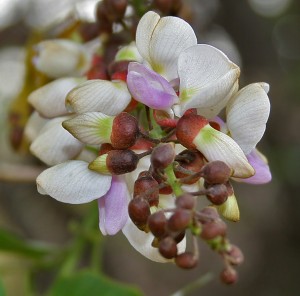Economic importance of Semecarpus anacardium

Kingdom: Plantae
Order: Sapindales
Family: Anacardiaceae
Genus: Semecarpus
Species: S. anacardium
Common name: Bhilawa
Origin: India
Description: Semecarpus anacardium is a deciduous tree. Its leaves are 7-24 inches long and 2-12 inches wide mostly rounded a t the tip. It has rounded, heart-shaped or narrowed leaf base with leathery in texture. Flowers are small and shorter than the leaves. Fruit is an inch long mooth and shining. It turns black when ripe. The nut is about 2.5 cm long, ovoid and smooth lustrous black.
Economic Importance:
-

Semecarpus anacardium_Tree Fleshy, orange cup of the fruit eaten when ripe, significantly astringent. Pericarp abounds in a black, oily, bitter, and highly vesicant juice, which has been traditionally used for marking linen. Vesicant juice which is known in the trade as Bhilawan Shell Liquid (BSL) is a rich source of phenols. A number of processes have been developed and patented for converting BSL into non- vesicating semi- solid or solid resins, which are utilised as bases for manufacture of varnishes, lacquers, enamels, paints, moulding compositions, and water proofing and insulating electrical materials. In the processes employed for extraction of shell liquid and subsequent treatment of the liquid for conversion into resins, catechol, an essential oil, and a high boiling phenolic constituent are obtained as by-products.
- Kernels edible; yield a semi- drying oil used as a wood preservative and as a lubricant for wooden axles of carts.
- Wood suitable for cheap and light furniture, packing boxes, and splints.
- Tree exudes a gum –resin used in leprosy and nervous debility.
- Juice from the pericarp is an ingredient of marking inks.
- Fruits used for ascites, rheumatism, asthma, epilepsy, and psoriasis, and also for warts and tumours. Biological tests have shown that extract of the fruit is effective against human epidermoid carcinoma of the nasopharynx in tissue culture; extract also shows hypoglycaemic action.



Sir/Madam
good & informative data,since from last 20 year we establish in industry bhilwa nut shell oil
Any more information contact e mail id mayadeepind@gmail.com mobile no 09850481749